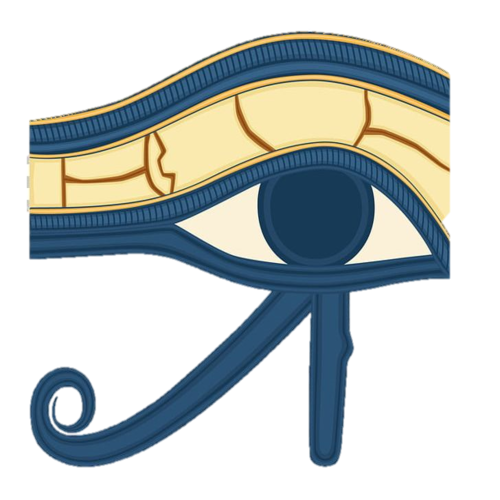The royal titulary or royal protocol of an Egyptian Pharaoh is the standard naming convention taken by the kings of Ancient Egypt. It symbolises worldly power and holy might and also acts as a sort of mission statement for the reign of a monarch (sometimes it even changed during the reign).
The full titulary, consisting of five names, did not come into standard usage until the Middle Kingdom but remained in use as late as the Roman Empire.
The Horus Name
| |
This name was usually written in a serekh, a representation of a palace façade. The name of the pharaoh was written in Hieroglyphics inside this representation of a palace. Typically an image of the falcon God Horus was perched on top or beside it.
This is the oldest form of the pharaoh’s name, originating in the Predynastic Period. Many of the oldest-known Egyptian pharaohs were known only by this title. The king was thought to be the earthly embodiment of Horus.
At least one Egyptian ruler, the Second Dynasty Seth-Peribsen, used an image of the god Seth instead of Horus, perhaps signifying an internal religious division within the country. He was succeeded by Khasekhemwy, who placed the symbols of both Set and Horus above his name. Thereafter, the image of Horus always appeared alongside the name of the pharaoh.
By the time of the New Kingdom the Horus name was often written without the enclosing serekh.
The Nebty (Two Ladies) Name
| |
The nebty name (lit. "two ladies") was associated with the so-called "heraldic" goddesses of Upper and Lower Egypt:
- Nekhbet, patron deity of Upper Egypt, represented by a vulture, and
- Wadjet, patron deity of Lower Egypt, represented by a cobra.
The name is first definitively used by the First Dynasty pharaoh Semerkhet, though it only became a fully independent title by the Twelfth Dynasty.
This particular name was not typically framed by a cartouche or serekh, but always begins with the hieroglyphs of a vulture and cobra resting upon two baskets, the dual noun "nebty".
The Horus of Gold
| |
Also known as the Golden Horus Name, this form of the pharaoh's name typically featured the image of a Horus falcon perched above or beside the hieroglyph for gold.
The meaning of this particular title has been disputed. One belief is that it represents the triumph of Horus over his uncle Seth, as the symbol for gold can be taken to mean that Horus was "superior to his foes". Gold was also strongly associated in the ancient Egyptian mind with eternity, so this may have been intended to convey the pharaoh's eternal Horus name.
Like the Nebty name, this particular name was not typically framed by a cartouche or serekh. It always begins with the depiction of the horus falcon perched above a representation of the sun.
The Throne Name (Praenomen)
| |
The pharaoh's throne name, the first of the two names written inside a cartouche, and usually accompanied the title nesu-bity, "King of Upper and Lower Egypt"; the epithet neb tawy, "Lord of the Two Lands", referring to valley and delta regions of Egypt, often occurs as well. In older literature it is often stated that nesu-bity literally means "He of the Sedge and Bee". It is now thought that the two words are related to other Afro-Asiatic words (in particular, Berber languages) meaning "strong man", "ruler", and the like.
This form of the name first came to prominence at the end of the Third Dynasty, and later would become the most important official title of the king.
The Personal Name (Nomen)
| |
This was the name given to the crown prince at birth. The name itself was preceded by the title "Son of Ra," written with the hieroglyph of a duck (za), a homonym for the word meaning "son" (za), adjacent to an image of the sun, a hieroglyph for the chief solar deity Ra. It was first introduced to the set of royal titles in the Fourth Dynasty and emphasizes the king's role as a representative of the solar god Ra.
Modern historians typically refer to the ancient kings of Egypt by this name, adding ordinals (e.g. "II", "III") to distinguish between different individuals bearing the same name.
Examples of the full titulary
In the Middle Kingdom, the full titulary was sometimes written in a single cartouche, as in this example from Senusret I, from Beni Hasan.
| Thutmose III in Hieroglyphs | |||||||||||||||||||
|---|---|---|---|---|---|---|---|---|---|---|---|---|---|---|---|---|---|---|---|
| serekh or Horus name | |||||||||||||||||||
|
|||||||||||||||||||
| Nebty name | |||||||||||||||||||
|
|||||||||||||||||||
| Golden Horus name | |||||||||||||||||||
|
|||||||||||||||||||
| praenomen or throne name | |||||||||||||||||||
|
|||||||||||||||||||
| nomen or birth name | |||||||||||||||||||
|
The full titulary of Eighteenth Dynasty pharaoh Thutmose III, providing a guide to pronunciation and its equivalent meaning, is as follows
- Horus Name: Kanakht Khaemwaset (Horus Mighty Bull, Arising in Thebes)
- Nebty Name: Wahnesytmireempet (He of the Two Ladies, Enduring in kingship like Re in heaven)
- Horus of Gold: Sekhempahtydsejerkhaw (Horus of Gold Powerful of strength, Sacred of appearance)
- Praenomen: Menkheperre (He of the Sedge and the Bee, Enduring of form is Re)
- Nomen: Thutmose Neferkheperu (Son of Ra, Thutmose, beautiful of forms)
References
- Dodson, Aidan Mark, and Dyan Hilton (2004). The Complete Royal Families of Ancient Egypt. Cairo, London, and New York: The American University in Cairo Press and Thames and Hudson. ISBN 977-424-878-3.
- Gardiner, Alan Henderson (1957). Egyptian Grammar; Being an Introduction to the Study of Hieroglyphs, 3rd, Oxford: Griffith Institute.
- Quirke, Stephen G. J. (1990). Who Were the Pharaohs? A History of Their Names with a List of Cartouches. London: British Museum Publications Limited.
- Schneider, Thomas (1993). "Zur Etymologie der Bezeichnung ‘König von Ober- und Unterägypten’". Zeitschrift für ägyptische Sprache und Altertumskunde 120: 166–181.
- Jürgen von Beckerath (1999). Handbuch der ägyptischen Königsnamen, 2nd edition, Mainz am Rhein: Verlag Philipp von Zabern.

